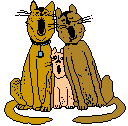 HOW CATS COMMUNICATE
WITH US - AND EACH OTHER!
HOW CATS COMMUNICATE
WITH US - AND EACH OTHER! HOW CATS COMMUNICATE
WITH US - AND EACH OTHER!
HOW CATS COMMUNICATE
WITH US - AND EACH OTHER!
![]() Purring
Purring
Purring is just one of the ways which
cats communicate. Experts seem to be constantly debating all of the
hows and why of purring, but any cat owner will tell you that it's the
sound of a contented cat! Experts have also stated that cats purr
when they are sick or injured. They purr when they are dying unless
death comes suddenly and unexpectedly.
![]() The
Meow, The Yowl, The Screech,
The
Meow, The Yowl, The Screech,
And Hissing
The meows can mean a number of things. They can be loud and demanding, or short and sweet. Tiny mews are carry-overs from kitten hood. Cats use this very effective ploy to get what they want.
At the other end of this wide vocal range is that out-and-out yowl that grates on the ears and the nerves. Translated: "I WANT IT NOW!"
The screech is a sound that pierces your very soul! It's a high-pitched banshee wail that is calculated to scare off any opponent. If one cat doesn't retreat from the face-off, the caterwauling can go on for hours. It is an energizing, courage-mustering ploy that's similar to the yell of a karate expert as he delivers a blow!
Hissing is another unmistakable sound. When you hear that, you know that your cat is telling you that it means business and you'd better back off! It translates as "I'm ready for trouble, so you'd better not mess around!" A few cat experts have suggested that this is the cat's way of imitating a snake, but most professionals don't agree. Hissing, more likely, is a cat's very own Defensive Early Warning System!
![]() Tail
Tips
Tail
Tips
![]() Each
movement of a cat's tail sends out a signal that we, as humans, can
Each
movement of a cat's tail sends out a signal that we, as humans, can
decode.
![]() A
tail that is slightly raised and softly curved indicates that the cat is
becoming interested in
something. When you are training your cat, you'll know if it
is catching on by watching it's tail react.
A
tail that is slightly raised and softly curved indicates that the cat is
becoming interested in
something. When you are training your cat, you'll know if it
is catching on by watching it's tail react.
![]() A
tail that is held very erect but with the tip tilted over shows that the
cat is curious, but has certain reservations. It is somewhat puzzled.
A
tail that is held very erect but with the tip tilted over shows that the
cat is curious, but has certain reservations. It is somewhat puzzled.
![]() A
tail that is fully erect, with the tip stiffly vertical, shows an intense
greeting signal with no
reservations.
A
tail that is fully erect, with the tip stiffly vertical, shows an intense
greeting signal with no
reservations.
![]() When the tail is held still but with the tip twitching, it means that the
cat is mildly irritated. If the tip twitching becomes more pronounced--watch
out! This cat is getting angry.
When the tail is held still but with the tip twitching, it means that the
cat is mildly irritated. If the tip twitching becomes more pronounced--watch
out! This cat is getting angry.
![]() When
a female holds her tail over to one side, she's in heat. The tail
held askew is a sexual
invitation to the tomcat, who then knows he can mount her without
fear of reprisal.
When
a female holds her tail over to one side, she's in heat. The tail
held askew is a sexual
invitation to the tomcat, who then knows he can mount her without
fear of reprisal.
![]() When the tail is arched and bristled, the cat is firmly in a defensive
mode and is preparing to respond
to a threat or an attack. This, again, is a strong signal of
potential danger. If the cat continues to feel provoked, an attack
will follow.
When the tail is arched and bristled, the cat is firmly in a defensive
mode and is preparing to respond
to a threat or an attack. This, again, is a strong signal of
potential danger. If the cat continues to feel provoked, an attack
will follow.